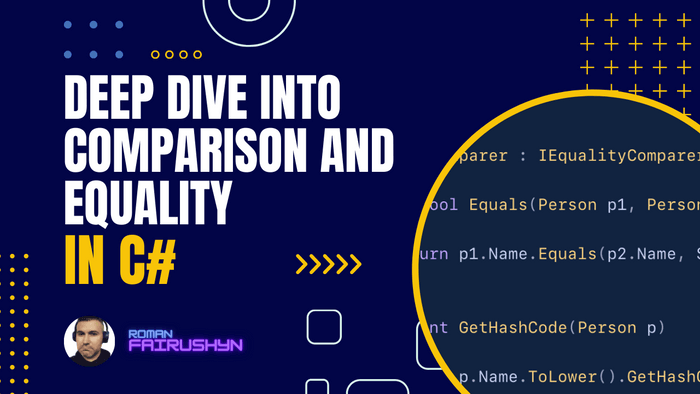Deep Dive into Comparison and Equality in C#
3 min read · — #csharp-interview#middle-specialist#comparison#equality
In the vast landscape of programming, the subject of "comparison" is akin to an old, wise sage; it appears deceptively
simple, yet hides profound depth. As Software Engineers, it's tempting to presume that such basic concepts are
beyond scrutiny. After all, how complex can a == b truly be? But, as with many aspects of C#, peeling back the layers
reveals a host of intricacies. In a mission-critical application, not knowing the subtle nuances can lead to elusive
bugs and potential performance issues. So, let's embark on an exploration of comparison and equality in C#, not as
beginners, but as seasoned coders, seeking the layers beneath the obvious.
1. Primitive Types: The Basics
In C#, for built-in primitive types (like int, double, char), the == operator compares values for equality.
Example:
int a = 5;
int b = 5;
Console.WriteLine(a == b); // True2. Reference Types: More than Meets the Eye
With reference types, the == operator compares memory addresses (references), not the content of the objects.
Example:
string str1 = new string(new char[] { 't', 'e', 's', 't' });
string str2 = new string(new char[] { 't', 'e', 's', 't' });
Console.WriteLine(str1 == str2); // True, but wait! There's more.Surprisingly, it returns True. This is because of string interning, a unique behavior of strings in .NET.
However, consider:
class Person
{
public string Name { get; set; }
}
var person1 = new Person { Name = "Alice" };
var person2 = new Person { Name = "Alice" };
Console.WriteLine(person1 == person2); // FalseTo compare the content of objects, you'd use the Equals() method:
Console.WriteLine(person1.Equals(person2)); // False (still!)This is because the default implementation of
Equals()checks reference equality. To check for content equality, you would need to override theEquals()method for your class.
3. Overriding Equals() and GetHashCode()
When overriding Equals(), it's also good practice to override GetHashCode().
Example:
class Person
{
public string Name { get; set; }
public override bool Equals(object obj)
{
var otherPerson = obj as Person;
return otherPerson != null && Name == otherPerson.Name;
}
public override int GetHashCode()
{
return Name?.GetHashCode() ?? 0;
}
}4. Structural Equality with Value Types
Structs in C# provide value-type semantics. By default, they derive their Equals() and GetHashCode()
from ValueType,
which gives a field-by-field comparison.
struct Point
{
public int X { get; set; }
public int Y { get; set; }
}
var point1 = new Point { X = 1, Y = 2 };
var point2 = new Point { X = 1, Y = 2 };
Console.WriteLine(point1.Equals(point2)); // True5. Equality Comparer
For situations where you need customized equality checks, or checks that don't modify the objects themselves, you can
utilize IEqualityComparer<T>.
Example:
class PersonComparer : IEqualityComparer<Person>
{
public bool Equals(Person p1, Person p2)
{
return p1.Name.Equals(p2.Name, StringComparison.OrdinalIgnoreCase);
}
public int GetHashCode(Person p)
{
return p.Name.ToLower().GetHashCode();
}
}6. Conclusion
In conclusion, while C# provides a range of tools to handle equality, understanding their behaviors and quirks is
crucial. As Software Engineers, diving deep into such foundational topics not only enriches our knowledge but can
be the difference between a smoothly running system and one riddled with subtle issues. So, the next time you're about
to use == or Equals(), pause for a moment and consider the richness of the journey that such a simple act can embark
upon.
